
Groundbreaking Simulations Reveal New Insights into Light QCD Axions and Neutron Star Cooling
2025-01-14
Author: Rajesh
Neutron stars, the remnants of colossal stars that have exploded in supernovae, are powerful laboratories for probing exotic physics. Their incredible density creates extreme temperatures and pressures, offering a unique environment to investigate fundamental particles.
Recent advancements in theoretical physics have sparked interest in the role of quantum chromodynamics (QCD) axions—hypothetical elementary particles predicted by the Peccei-Quinn mechanism. These axions could significantly impact the structure and cooling processes of neutron stars by interacting with their constituent nucleons.
Researchers from the University of Alicante and the Technical University of Munich have conducted pioneering simulations to understand how these QCD axions might affect neutron star cooling. Their findings, recently published in *Physical Review Letters*, establish new constraints on the properties of light QCD axions, paving the way for future detections and studies of these elusive particles.
Antonio Gómez-Bañón, the lead author of the study, shared insights into the motivation behind this research. "We began exploring the potential influence of a hypothetical particle like the QCD axion on nuclear matter properties. This led us to realize that if the QCD axion were light enough, it could drastically change the thickness of a neutron star's envelope, which plays a crucial role in regulating its cooling."
The researchers sought to understand whether a QCD axion's influence on the neutron star envelope could accelerate its cooling rate to a degree that contradicted existing observational data. They investigated how these particles would impact the energy and pressure of the nuclear matter within these stars.
Gómez-Bañón elaborated, "We addressed the balance of forces between the QCD axion field, nuclear matter, and the inherent gravitational forces within a neutron star by solving differential equations. Our research revealed that for certain parameters, the neutron star's envelope could become significantly thinner."
This thinning effect implies less insulation for the neutron star, leading to a faster cooling rate. To validate their theoretical predictions, the researchers integrated these equilibrium equations into their simulations and tracked changes in temperature over time.
"Our cooling curve simulations indicated that the neutron stars predicted by our models were cooler than those observed at the same ages," Gómez-Bañón noted. "This significant discrepancy enables us to impose new constraints on parameters related to QCD axions."
In their comprehensive analysis, the team successfully eliminated a previously unexplored region within the QCD axion parameter space, heralding a new method for constraining these hypothetical particles based on neutron star observations rather than energy loss from axion emissions.
Looking ahead, Gómez-Bañón and his collaborators aim to identify astrophysical scenarios that could further constrain what is often referred to as 'the QCD Axion Line'—a mass range theorized for axions, which has proven difficult to investigate. Ruling out parts of this region represents not just a significant accomplishment in the field but could also have profound implications for our understanding of dark matter and the fundamental forces governing the universe.
As this groundbreaking research continues to unfold, the implications extend beyond mere theoretical physics; we may be on the verge of uncovering secrets about the very fabric of reality. Stay tuned, as the quest for knowledge about QCD axions and their role in the cosmos is just beginning!
 Brasil (PT)
Brasil (PT)
 Canada (EN)
Canada (EN)
 Chile (ES)
Chile (ES)
 Česko (CS)
Česko (CS)
 대한민국 (KO)
대한민국 (KO)
 España (ES)
España (ES)
 France (FR)
France (FR)
 Hong Kong (EN)
Hong Kong (EN)
 Italia (IT)
Italia (IT)
 日本 (JA)
日本 (JA)
 Magyarország (HU)
Magyarország (HU)
 Norge (NO)
Norge (NO)
 Polska (PL)
Polska (PL)
 Schweiz (DE)
Schweiz (DE)
 Singapore (EN)
Singapore (EN)
 Sverige (SV)
Sverige (SV)
 Suomi (FI)
Suomi (FI)
 Türkiye (TR)
Türkiye (TR)
 الإمارات العربية المتحدة (AR)
الإمارات العربية المتحدة (AR)